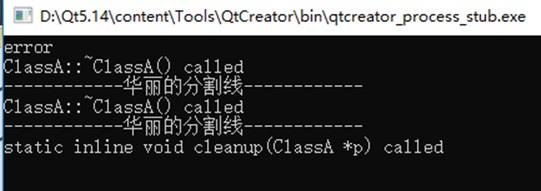Qt文档阅读笔记-QScopedPointer解析及实例
Posted IT1995
tags:
篇首语:本文由小常识网(cha138.com)小编为大家整理,主要介绍了Qt文档阅读笔记-QScopedPointer解析及实例相关的知识,希望对你有一定的参考价值。
当指针超出范围后就会删除被引用的对象。 与QPointer不同,他可以在任意类型中使用(QPointer只能在identity type中使用) 4个不同的清除类 1. QScopedPointerDeleter 2. QScopedPointerArrayDeleter 3. QScopedPointerArrayDeleter 4. QScopedPointerDeleteLater 如下例子:QScopedPointer<int, QScopedPointerArrayDeleter<int>> intArrayPointer(new int(100)); 在如下几个方面用得比较多: 异常 使代码简洁 通常用于删除动态分配的变量。QPointerQScopedPointer基本上用用动态分配的对象,在范围外自动进行释放,这个范围是通过包起来的,也就是函数的生存周期。
如下面这个原始代码:
void myFunction(bool useSubClass)
MyClass *p = useSubClass ? new MyClass() : new MySubClass;
QIODevice *device = handsOverOwnership();
if (m_value > 3)
delete p;
delete device;
return;
try
process(device);
catch (...)
delete p;
delete device;
throw;
delete p;
delete device;
使用了QScopedPointer后:
void myFunction(bool useSubClass)
// assuming that MyClass has a virtual destructor
QScopedPointer<MyClass> p(useSubClass ? new MyClass() : new MySubClass);
QScopedPointer<QIODevice> device(handsOverOwnership());
if (m_value > 3)
return;
process(device);
带限定符的C++指针使用QScopedPointer:
const QWidget *const p = new QWidget();
// is equivalent to:
const QScopedPointer<const QWidget> p(new QWidget());
QWidget *const p = new QWidget();
// is equivalent to:
const QScopedPointer<QWidget> p(new QWidget());
const QWidget *p = new QWidget();
// is equivalent to:
QScopedPointer<const QWidget> p(new QWidget());自定义清空
相当于delete操作QScopedPointerDeleter
相当于delete []操作QScopedPointerArrayDeleter
相当于free操作QScopedPointerPodDeleter
相当于deleteLater操作QScopedPointerDeleteLater
代码如下:
// this QScopedPointer deletes its data using the delete[] operator:
QScopedPointer<int, QScopedPointerArrayDeleter<int> > arrayPointer(new int[42]);
// this QScopedPointer frees its data using free():
QScopedPointer<int, QScopedPointerPodDeleter> podPointer(reinterpret_cast<int *>(malloc(42)));
// this struct calls "myCustomDeallocator" to delete the pointer
struct ScopedPointerCustomDeleter
static inline void cleanup(MyCustomClass *pointer)
myCustomDeallocator(pointer);
;
// QScopedPointer using a custom deleter:
QScopedPointer<MyCustomClass, ScopedPointerCustomDeleter> customPointer(new MyCustomClass);下面是在类声明的时候要注意的问题:
class MyPrivateClass; // forward declare MyPrivateClass
class MyClass
private:
QScopedPointer<MyPrivateClass> privatePtr; // QScopedPointer to forward declared class
public:
MyClass(); // OK
inline ~MyClass() // VIOLATION - Destructor must not be inline
private:
Q_DISABLE_COPY(MyClass) // OK - copy constructor and assignment operators
// are now disabled, so the compiler won't implicitely
// generate them.
;运行截图如下:

代码如下:
#ifndef CLASSA_H
#define CLASSA_H
#include <QString>
#include <QDebug>
class ClassA;
struct ClassACustomDeleter
static inline void cleanup(ClassA *p)
qDebug() << "static inline void cleanup(ClassA *p) called";
delete p;
;
class ClassA
public:
ClassA();
~ClassA();
const QString &getStr();
const int &getValue();
private:
QString m_str;
int m_value;
;
#endif // CLASSA_HClassA.cpp
#include "ClassA.h"
#include <QDebug>
ClassA::ClassA() : m_str("字符串"), m_value(10)
ClassA::~ClassA()
qDebug() << "ClassA::~ClassA() called";
const QString &ClassA::getStr()
return m_str;
const int &ClassA::getValue()
return m_value;
main.cpp
#include <QCoreApplication>
#include <QDebug>
#include <QScopedPointer>
#include "ClassA.h"
void normalFunction()
ClassA *a = new ClassA;
try
if(0 == 0)
throw "error";
catch(char const *err)
qDebug() << err;
delete a;
return;
//want to do sth
//...
//well
delete a;
void usingQScopedFunction()
QScopedPointer<ClassA> p(new ClassA);
void usingQScopedCustomFunction()
QScopedPointer<ClassA, ClassACustomDeleter> p(new ClassA);
int main(int argc, char *argv[])
QCoreApplication a(argc, argv);
normalFunction();
qDebug() << "------------华丽的分割线------------";
usingQScopedFunction();
qDebug() << "------------华丽的分割线------------";
usingQScopedCustomFunction();
return a.exec();
以上是关于Qt文档阅读笔记-QScopedPointer解析及实例的主要内容,如果未能解决你的问题,请参考以下文章